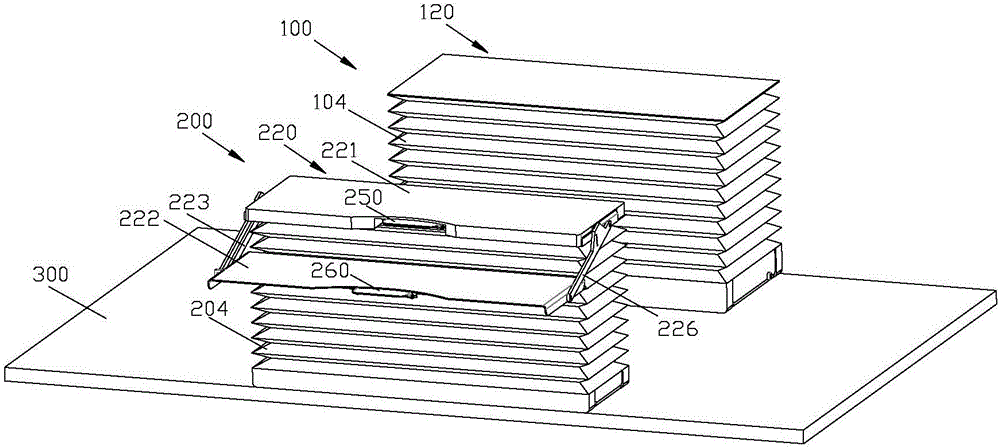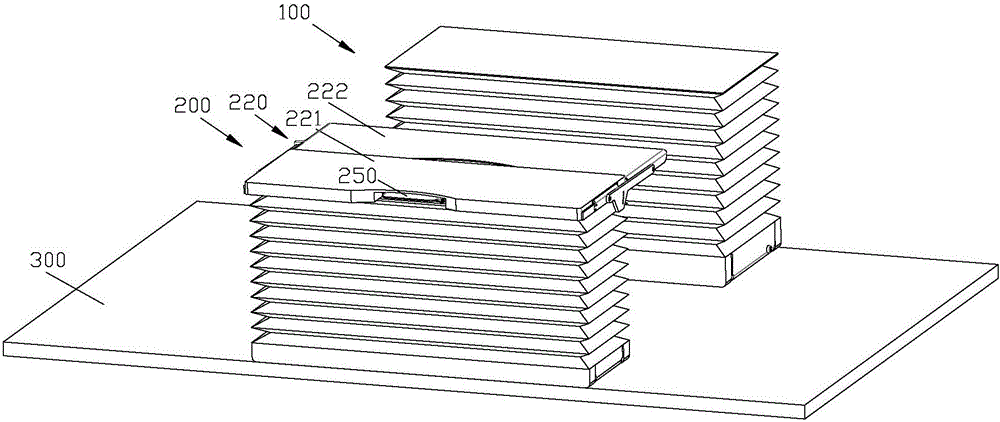Equipment position adjusting device
A technology for adjusting the position of devices and equipment, which is applied in the direction of desks or desks, desks, workbenches, etc. of computer workstations, and can solve problems such as physical strain, users' reluctance to adjust, and depressive atmosphere
- Summary
- Abstract
- Description
- Claims
- Application Information
AI Technical Summary
Problems solved by technology
Method used
Image
Examples
Embodiment 1
[0096] Referring to the attached picture: Figure 1-Figure 8 .
[0097] Such as figure 1 , figure 2 , image 3 As shown, the equipment position adjustment device includes two lifting devices 100, 200 that are arranged on the horizontal bottom surface 300 and only perform telescopic movement in the vertical direction. There is a gap between the devices 100, 200;
[0098] It also includes a first top assembly 120 for placing equipment that needs to avoid shaking and a second top assembly 220 for placing equipment that can shake during operation, and the first top assembly 120 and the second top assembly 220 are respectively installed on two a lifting device 100, 200;
[0099] The lifting device 100, 200 drives the first top assembly 120 and the second top assembly 220 to move only in the vertical direction, and the angles between the first top assembly 120 and the second top assembly 220 and the horizontal bottom surface 300 remain unchanged;
[0100] The second top assem...
Embodiment 2
[0233] Refer to attached Figure 12 , Figure 13 as well as Figure 1-Figure 8 .
[0234] The difference between this embodiment and embodiment 1 is that the structure of the lifting device is different.
[0235] Such as Figure 12 , Figure 13 , the lifting device includes a second base 101b and a second top plate, the second major axis 151 is parallel to the second base 101b, and the first oblique rod 147 and the second oblique rod 148 are respectively rotatably sleeved on the second major axis 151 at both ends, and the first slanting rod 147 and the second slanting rod are arranged crosswise;
[0236] The bottom end of the first inclined rod 147 is rotatably arranged on the second base 101b through the second transverse axis 142b, and the second transverse axis 142b is parallel to the second major axis 151; the bottom end of the second inclined rod 148 passes through the first the sliding hinge device is slidably arranged on the second base 101b;
[0237] The top end...
Embodiment 3
[0270] Refer to attached Figure 14 as well as Figure 1-Figure 8 .
[0271] The difference between this embodiment and Embodiment 1 is that the structure of the lifting device is different.
[0272] as attached Figure 14 As shown, the lifting device includes a third base 101c and a third top board, and also includes several sets of hinged rod combinations hinged between the third base 101c and the third top board. In this embodiment, two groups of hinged rod combinations are preferred; The rod combination includes several groups of X-shaped brackets that are hinged up and down. In this embodiment, a preferred group of hinged rod combinations includes 2 groups of X-shaped brackets; The long rods 149c, 159, 158, 148c are cross-hinged;
[0273] Two X-shaped supports adjacent up and down are formed by the end of the first long rod 157,160 of the X-shaped support above, the end of the second long rod 159,158 and the second long rod of the X-shaped support below. The top ends...
PUM
 Login to View More
Login to View More Abstract
Description
Claims
Application Information
 Login to View More
Login to View More - R&D
- Intellectual Property
- Life Sciences
- Materials
- Tech Scout
- Unparalleled Data Quality
- Higher Quality Content
- 60% Fewer Hallucinations
Browse by: Latest US Patents, China's latest patents, Technical Efficacy Thesaurus, Application Domain, Technology Topic, Popular Technical Reports.
© 2025 PatSnap. All rights reserved.Legal|Privacy policy|Modern Slavery Act Transparency Statement|Sitemap|About US| Contact US: help@patsnap.com



